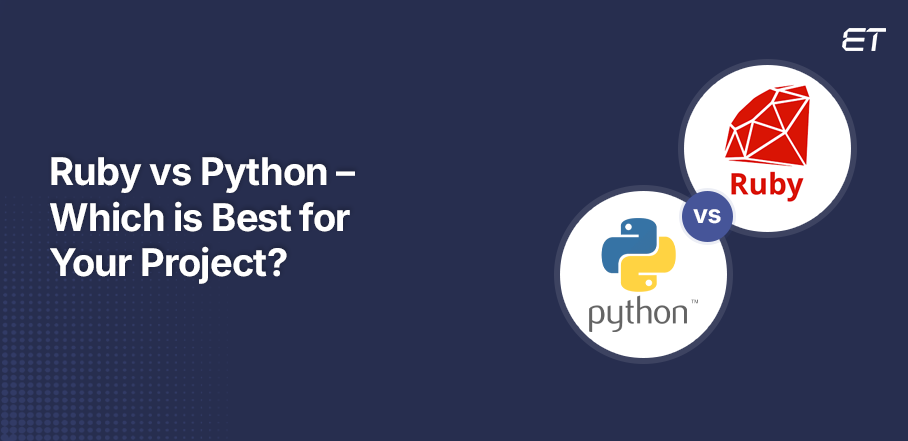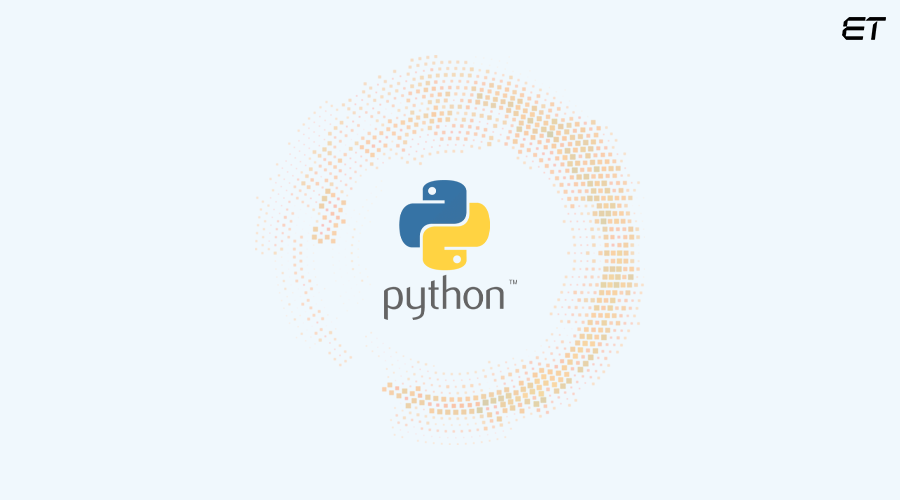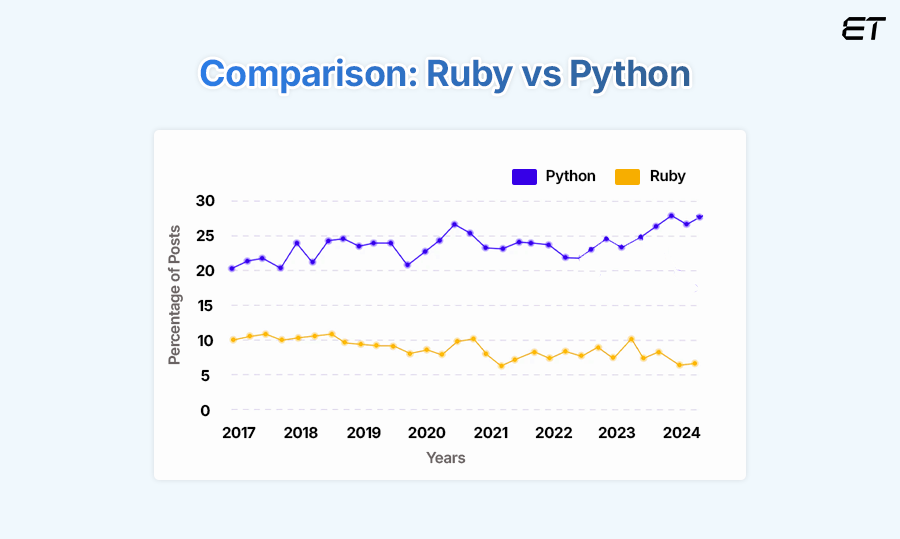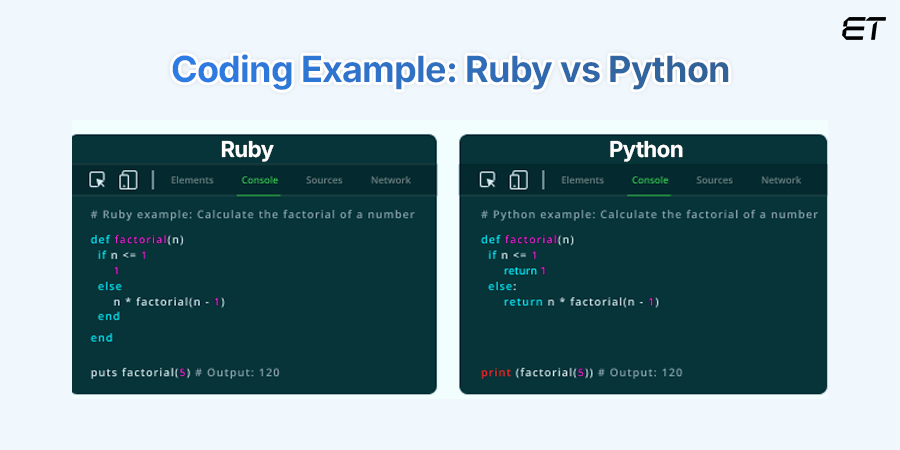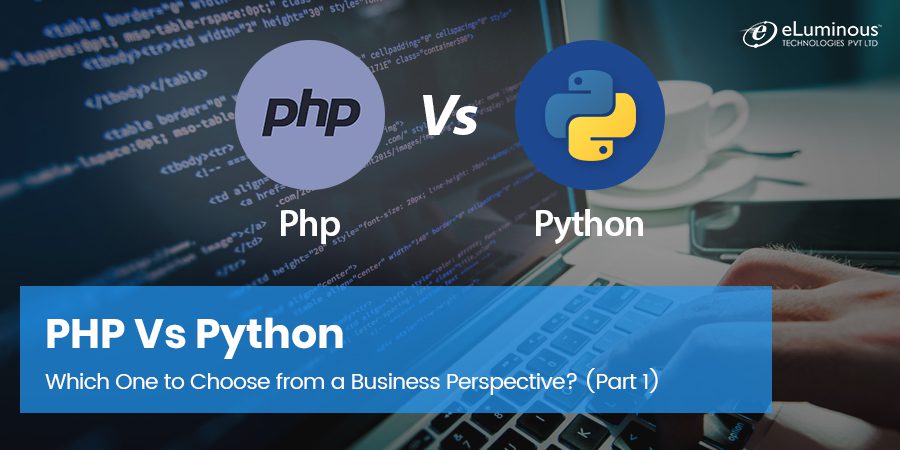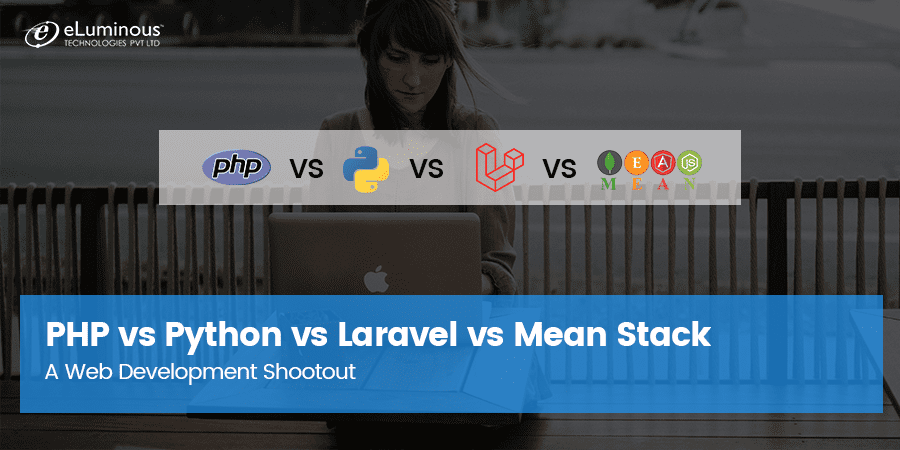Choosing the right programming language for your next project can be like picking a route on a road trip — one wrong turn, and you might end up far from your desired destination. Relatable?
When it comes to backend development, two languages often stand out in the discussion — Ruby vs Python. Both have unique strengths and devoted communities, making your choice is not just a technical decision but a strategic one for your business. It depends on what you’re looking for. For instance, are you looking for a language that offers rapid web development with elegance? Or do you need a versatile tool that excels in data science and AI?
In this blog, we’ll discuss the Ruby vs Python debate to help you make an informed decision that aligns perfectly with your business goals and future growth. So, buckle up as we discuss this and find the best route for your journey ahead.
Ruby vs Python: Understanding Ruby
Ruby is an open-source, dynamic programming language known for its simplicity and productivity. It is designed to be intuitive and easy to read, making it perfect if you are someone who prioritizes clean and maintainable code.
- Ruby emphasizes a human-friendly syntax that mimics natural language, reducing the learning curve for newcomers.
- Ruby is particularly famous for its use in web development through the Ruby on Rails framework, which allows you to build robust web applications quickly and efficiently.
- With its strong focus on convention over configuration, Ruby streamlines the development process, enabling rapid application development without compromising on quality or scalability.
Ruby vs Python: Understanding Python
Python is a versatile, high-level programming language known for its readability and simplicity. Its design emphasizes code readability with its clear, English-like syntax, making it accessible for beginners and powerful for experts.
-
- Python supports multiple programming paradigms, including object-oriented, procedural, and functional programming, allowing you to choose the best approach for your projects.
- Python can be used in various fields, such as web development, data science, artificial intelligence, machine learning, and automation.
- With its extensive libraries and frameworks such as Django, Flask, TensorFlow, and Pandas, you can efficiently develop scalable applications, perform data analysis, and build complex algorithms.
- These aspects make it a top choice if you’re seeking flexibility and innovation.
Need help with web application development using Python?
Ruby vs Python? Here’s What Each Brings to the Table!
Now let’s understand the advantages of what Ruby vs Python offer and how you can benefit from them from the table below:
| Ruby | Python |
| Its syntax is intuitive and easy to read which reduces your development time. | Python has simple and straightforward syntax. |
| It enables you to create web applications quickly by spending less time on repetitive tasks and more time on building unique features. | It supports multiple programming paradigms which allows it to be used for various fields. |
| It has an active community that constantly contributes to its libraries and pre-packaged code. | It has a rich ecosystem of libraries and frameworks which allows it for efficient coding for your complex applications. |
| Its highly flexible, allowing you to freely alter parts of the language to fit your needs. | It can easily integrate with other technologies which makes it suitable for both small-scale, and large enterprise-level applications. |
| Its syntax and structure is natural and non-restrictive. | Its simplicity and extensive resources boosts your productivity and reduces time to market. |
| It’s ideal for startups and businesses looking to quickly prototype ideas. | Its powerful libraries and frameworks provide the necessary tools for complex projects. |
Ruby vs Python — What’s the Catch?
Although Ruby vs Python both have their own strengths, there’s another side of them too which limits their capabilities to a certain extent. Let’s take a look at the table below which discusses the limitations of both programming language for your better understanding:
| Ruby | Python |
| Ruby is generally slower than other programming languages like Python, Java, or C++. | Python is an interpreted language, which generally makes it slower in execution compared to compiled languages like C++ or Java. |
| Its Global Interpreter Lock restricts the execution of multi-threaded applications that require high concurrency and parallelism. | Python’s simplicity comes with a cost-higher memory usage. This makes it less suitable for memory-constrained applications. |
| It has a smaller ecosystem for other domains like AI, ML, etc, when we talk in terms of Ruby vs Python comparison. | Python’s frameworks are less mature than Swift or Kotlin for mobile app development. |
| Ruby’s library and tool ecosystem is not as extensive or mature, which limits it. | Python’s GIL ensures that only one thread executes at a time which limits its efficiency. |
| The availability of Ruby developers and community is affected and it has seen a decline in popularity over the years. | While Python is used in many enterprise applications, it lacks some of the built-in tools and features. |
| Ruby has a higher learning curve for complex projects. | Its high-level nature and focus on ease of use make it limited by design for low-level programming. |
To build a strong core for your digital success you need to power your project with a solid backend. Wondering how to do it?
Comparison Analysis — Ruby vs Python
Now that you understand the advantages and limitations of the Ruby vs Python comparative options, let’s move on to our next and important section. Differentiating between the two is crucial to making informed decisions for your next project.
Without much ado, let’s get started. But before we move on to the detailed comparison, let’s look at the differences in a nutshell.
| Aspect | Ruby | Python |
| Performance | Focuses on web development speed, but can be slower for compute-heavy tasks. | Offers better performance for data-heavy tasks, scientific computing, and AI. |
| Development Speed & Efficiency | Enables rapid web application development with a focus on convention-over-configuration. | Its simplicity and readability makes it highly flexible across applications. |
| Scalability & Maintainability | Scales well with monolithic architectures but can be challenging to maintain as the codebase grows. | Supports both monolithic and microservices architectures, making it scalable and easy to maintain. |
| Ecosystem & Libraries | Rich ecosystem for web development; fewer libraries for data science or AI. | Extensive libraries and frameworks for web development, data science, AI, etc. |
| Community & Support | Strong but niche community focused mainly on web developers; lesser variety in available resources. | Larger and more diverse community, providing extensive resources, tutorials, and support for varied use cases. |
| Security & Business Risks | Secure but may require additional manual interventions. | Strong security features with built-in tools and third-party libraries. |
| Cost Implications & Hiring Experts | Smaller talent pool with potentially higher hiring costs; specialized skills may demand premium rates. | Broader talent pool with generally more competitive rates; easier to find developers with versatile skill sets. |
| Real-World Example | Airbnb, Shopify, GitHub | Google, Spotify, Netflix |
1. Performance
Ruby is known for its elegant syntax that eases your coding work, which often translates to faster development times, especially for your web applications. The Ruby on Rails framework, in particular, allows you to build robust applications quickly due to its “convention over configuration” philosophy.
- Ruby’s execution speed is generally slower in Ruby vs Python comparison.
- It’s not that Ruby is inherently slow, but its runtime may face challenges with performance-heavy tasks.
- This limitation makes Ruby less suitable for applications that require high speed and efficiency.
- Examples of such applications include real-time data processing and high-frequency trading systems.
On the other hand, Python is generally faster than Ruby and is optimized for performance, particularly in data-heavy tasks. Python’s efficiency shines in fields like data science, machine learning, and scientific computing, where the ability to handle large datasets and perform complex calculations quickly is crucial. Apart from this,
- Python has a rich ecosystem of optimized libraries, such as NumPy, pandas, and TensorFlow.
- These libraries enhance the performance capabilities of Python applications.
- However, Python can sometimes be slower in execution speed compared to compiled languages. This is due to Python’s interpreted nature.
In the performance debate of Ruby vs Python, which is the preferred choice?
Python
2. Development Speed and Efficiency
Ruby was designed with the developer’s experience in mind. Its syntax is intuitive and close to natural language, which means you can write less code to achieve more.
- This reduces your development time significantly, especially if your web application is built with Ruby on Rails.
- Ruby on Rails follows the “convention over configuration” principle, which minimizes the need for boilerplate code and repetitive tasks.
- This dynamic nature and metaprogramming capabilities also add a layer of flexibility that allows you to modify code at runtime, making it adaptable to rapid changes.
This makes Ruby a strong contender for you if you’re a startup or a business that needs to get your applications up and running quickly.
On the other hand, Python is known for its readability and simplicity. Python’s syntax is straightforward, making it easy for you to write clear and maintainable code.
- This clarity speeds up your development process and ensures that your teams can collaborate more effectively without getting bogged down by complicated syntax or obscure coding practices.
- Its extensive libraries and frameworks for various applications—web development, data science, or automation—allow you to build comprehensive solutions easily.
- Its flexibility is particularly evident in its capacity to handle a wide range of tasks with minimal code complexity.
Therefore, Python is highly versatile, which makes it easier to integrate with other technologies and extend functionalities as needed.
Ruby vs Python: Which one is the right choice for you in this?
Ruby
3. Scalability and Maintainability
Ruby, mainly when used with the Ruby on Rails framework, provides you with a solid foundation for building scalable web applications. Rails’ strong convention-based structure encourages clean, modular code that can be easily maintained and updated as your application grows. However,
- Ruby’s dynamic nature can sometimes make it harder to predict how your code will behave as the application scales.
- For very large-scale applications, this could lead to performance obstructions and require more effort in refactoring or optimizing the codebase.
Yet, if you have a skilled development team that follows best practices, Ruby applications can be scaled effectively to meet growing demands.
Python, by contrast, is often seen as more naturally suited to scalability and maintainability. Python’s straightforward and readable codebase makes it easier to manage large projects over time. This readability ensures that your team can easily understand, update, and debug the code, reducing the risk of errors and technical debt.
- Python’s vast ecosystem of libraries and frameworks, such as Django and Flask, also supports scalable architectures.
- These frameworks are designed to handle high traffic and large datasets, making Python a preferred choice for your applications that need to grow over time.
- Additionally, Python’s support for asynchronous programming allows for better performance in concurrent and parallel processing scenarios, which is essential for scalability in modern applications.
When it comes to Ruby vs Python, which language should you prefer?
Python
Want to unlock end-to-end solutions for your app? Explore our Full-Stack expertise and discover how we build it all!
4. Ecosystem and Libraries
With its famous Ruby on Rails framework, Ruby has an active ecosystem focused on web development. The Rails framework has a comprehensive set of built-in tools and libraries that cover most of what you need to build solid web applications quickly.
- The convention-over-configuration approach of Ruby simplifies your development process but can also limit its flexibility when stepping outside the bounds of typical web app functionality.
- Its ecosystem has a wealth of gems (libraries) that are easy to use and integrate.
- It provides solutions for your various tasks like authentication, payment processing, and more.
- However, the community is smaller than Python’s, which can sometimes provide fewer resources for niche problems or non-web-based applications.
Python stands out with its exceptionally diverse and expansive ecosystem, which spans beyond web development, AI, scientific computing, and more.
- Its libraries, like TensorFlow, NumPy, etc., offer you capabilities to cater to a wide range of needs.
- Python provides you with a clear advantage with its mature data science ecosystem and libraries if you want to venture into data-driven applications.
- The large, active community continuously contributes to its libraries. Due to this, more than one solution is often available to your problem, providing you with the flexibility of choice.
Ruby vs Python: Which justifies this point better?
Python
5. Community and Support
Ruby has a highly engaged community. There are numerous forums, meetups, and conferences dedicated to Ruby, such as RailConf, which provides you with excellent opportunities for networking and knowledge sharing. However,
- Ruby’s community is smaller in terms of Ruby vs Python comparison.
- The resources are fewer for more obscure issues or less mainstream use cases.
- There’s a possibility that you might find a limited number of experts for highly specialized problems.
On the other hand, Python benefits from one of the world’s largest and most active programming communities. With its widespread use, Python’s community spans diverse fields.
- Whether you’re a web developer, or researcher, there is a niche community within Python to help you.
- You can find extensive documentation, numerous online forums such as Stack Overflow, and dedicated community events like PyCon.
- The broad and active support system makes it easier to find help quickly for almost any issue, from simple coding questions to complex algorithm problems.
Ruby vs Python: What should be your preference?
Python
6. Security and Business Risks
Ruby offers several built-in security features that help you protect your application.
- Rails comes with automated protections against common vulnerabilities like SQL injection, cross-site scripting (XSS), and cross-site request forgery (CSRF)
- The Ruby community also proactively addresses security issues with regular updates and patches to fix known vulnerabilities.
- However, due to the smaller size of the community and limited resources, the response time to newly discovered security threats is slightly slower.
Python is widely regarded for its strong focus on code readability and simplicity, which reduces the likelihood of bugs and vulnerabilities.
- Its widespread use has driven a mature approach to security, with libraries like cryptography providing solid tools for your data protection.
- With its larger ecosystem of security libraries and tools, you can conveniently handle authentication and encryption.
- This enables you to identify and patch security vulnerabilities and problems quickly.
Ruby vs Python: What should your best pick be in security terms?
Python
7. Cost Implications and Hiring Experts
Ruby is popular and a preferred choice if you’re a startup or small-to-medium business looking to build scalable web applications quickly. However,
- Finding seasoned Ruby developers can sometimes be a challenge.
- The pool of experienced talent is relatively smaller in terms of Ruby vs Python comparison.
- This limited talent pool can lead to higher salaries and potentially increased hiring costs.
- Moreover, developers who specialize in specific areas may demand even more due to their niche skills.
Python, on the other hand, has a more extensive developer base available in the job market.
- This broad talent pool often leads to more competitive hiring rates, making it a more budget-friendly option.
- Additionally, you can easily onboard new developers or upskill your existing team.
- This reduces the long-term costs associated with training and development of your team.
Ruby vs Python – which language fits the cost point best?
Python
Want to transform your vision into reality? See how we make it happen!
Ruby vs Python — What to Choose for Your Business?
Now that we’ve covered all the pointers, you need to decide which one to choose — Ruby vs Python. It largely depends on your project requirements, team expertise, and business goals. Both programming languages are versatile and powerful but:
- If you’re focused on rapid web development and building MVPs (Minimum Viable Products) to test a business idea or launch a product quickly, Ruby is an excellent choice for you. It allows you for easy maintenance and scalability without getting bogged down in complex configurations. You can also opt for Ruby if you want to build an e-commerce platform like Shopify.
- On the other hand, if your projects involve data analysis, machine learning, complex computational tasks, or extensive customization, Python is your go-to. With its rich ecosystem of libraries, you can develop web applications, build a recommendation engine, a financial modeling tool, or an AI-powered chatbot.
Ultimately, the choice between the Ruby vs Python comparison point boils down to your project’s specific needs. Evaluate your business’s long-term goals, application type, and growth trajectory. By aligning these factors, you can make the best decision that optimizes your development process and business outcomes.
Want to jumpstart your next project? We’ve got you covered. Reach out to our experts if you have any queries or want assistance with development or any IT requirements.
Frequently Asked Questions
In Ruby vs Python comparison, which is faster?
Ruby’s performance in web development can be rapid with Ruby on Rails, but Python generally offers you better performance in data-heavy applications.
In the Ruby vs Python face-off, which is a better framework option between Ruby on Rails and Django?
Both are powerful frameworks; Ruby on Rails offers speed in development, while Django offers more flexibility and better scalability. The choice depends on your requirements.
Which is more secure — Ruby vs Python?
The Ruby vs Python comparison teaches us that both backend languages are secure if you follow their best practices. However, Python offers more libraries focused on enhancing security.
In Ruby vs Python comparison, is Ruby similar to Python?
Through the Ruby vs Python comparison, you can understand that the languages are similar in some ways, but not entirely. Both are known for their simplicity and readability. However, Ruby is often favored for rapid web development and building MVPs quickly, whereas Python is for data analysis, AI, and machine learning.
Excellence-driven professional with 15+ years of experience in increasing productivity, and revenue, while effectively managing products of all sizes. He has worked for international clients in the US, UK, and Singapore and local companies in various domains. With excellent attention to detail and a methodical approach to execution, he is an expert in bringing projects to a successful stage. He follows James Humes’s famous saying- “The art of communication is the language of leadership.”
